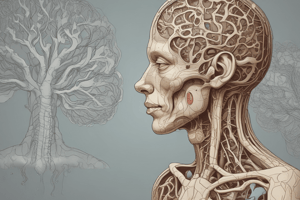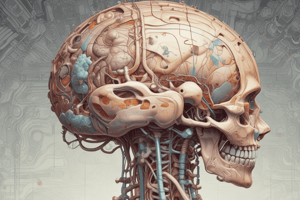Podcast
Questions and Answers
What is the main component of gray matter in the CNS?
What is the main component of gray matter in the CNS?
- Blood vessels
- Neuroglia
- Nerve cell bodies (correct)
- Nerve processes (axons)
What gives white matter its characteristic color?
What gives white matter its characteristic color?
- Presence of cerebrospinal fluid
- Large population of myelinated nerve processes (correct)
- Large population of nonmyelinated cell bodies
- Absence of neuroglia
What is the shape of the gray matter in the spinal cord?
What is the shape of the gray matter in the spinal cord?
- Rectangular
- H-shaped (or butterfly-shaped) (correct)
- Circular
- Spiral
What is the function of the meninges?
What is the function of the meninges?
What are the cranial and spinal nerves composed of?
What are the cranial and spinal nerves composed of?
What is a ganglion?
What is a ganglion?
How many pairs of cranial nerves are there?
How many pairs of cranial nerves are there?
What is the purpose of the foramina in the skull?
What is the purpose of the foramina in the skull?
Flashcards are hidden until you start studying
Study Notes
Central Nervous System (CNS)
- The CNS is organized into gray and white matter, differing in color tone due to the presence of myelinated nerve processes and neuroglia.
- Gray matter consists of nerve cell bodies embedded in neuroglia, appearing grayish in color.
- White matter consists of nerve processes (axons) and blood vessels embedded in neuroglia, appearing white and glistening due to myelinated nerve processes.
- In the spinal cord, gray matter forms an H-shaped (or butterfly-shaped) pattern with paired posterior, anterior, and lateral gray horns.
- A central canal containing cerebrospinal fluid runs along the internal length of the CNS.
Meninges
- The CNS is surrounded by three membranes: dura mater (outer), arachnoid mater (middle), and pia mater (innermost).
- The meninges serve to protect, anchor, and stabilize the CNS, and contain a surrounding sac of cerebrospinal fluid.
Peripheral Nervous System
- The peripheral nervous system consists of cranial and spinal nerves and their associated ganglia.
- A ganglion is a cluster of neuron cell bodies located outside the CNS.
- Cranial and spinal nerves appear as grayish white cords made up of bundles of neuron processes (axons) supported by delicate areolar tissue.
Cranial Nerves
- There are 12 pairs of cranial nerves that branch off the brain and upper spinal cord and pass through openings (foramina) in the skull.
- All cranial nerves are distributed in the head and neck except CN X (vagus nerve), which also supplies structures in the thorax and abdomen.
Spinal Nerves
- There are 31 pairs of spinal nerves that leave the spinal cord and pass through intervertebral foramina in the vertebral column.
- Spinal nerves are named according to the region of the vertebral column with which they are associated: 8 cervical, 12 thoracic, 5 lumbar, 5 sacral, and 1 coccygeal.
Studying That Suits You
Use AI to generate personalized quizzes and flashcards to suit your learning preferences.





